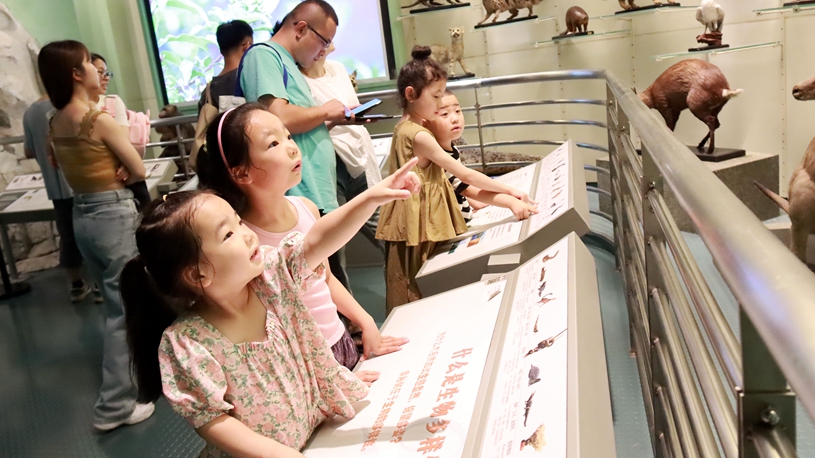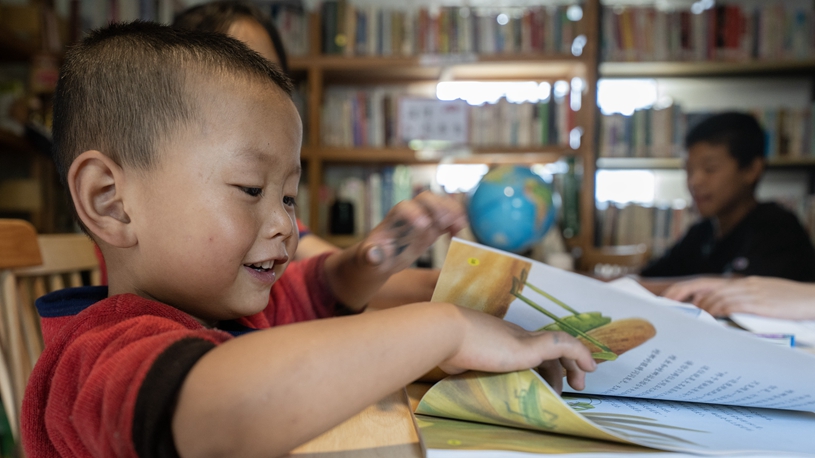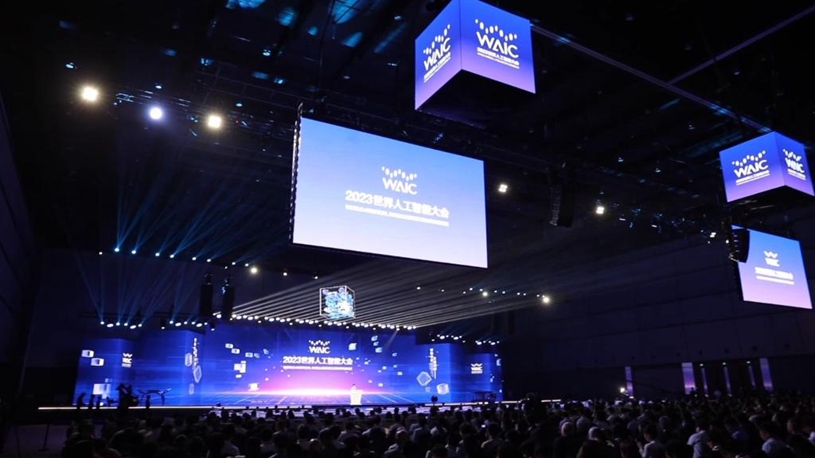*Jingdezhen's history in ceramic craftsmanship spans over 2,000 years. Its role as an official and imperial kiln in history propelled the art of porcelain making to unprecedented heights.
*Today, Jingdezhen stands as China's only national ceramic culture inheritance and innovation pilot zone, hosting more than 30,000 "Jingpiaos," or migrants who came to pursue their dreams.
*Jingdezhen has forged friendly relations with over 180 cities in 72 countries and regions worldwide, facilitating numerous ceramic-themed exchanges and research activities.
NANCHANG, July 9 (Xinhua) -- Tucked away in Chenjiafan Village in the suburbs of Jingdezhen, a world-famous "porcelain capital" in east China's Jiangxi Province, Denis Naymark's studio stands in a league of its own, showcasing exquisitely crafted works of art.
Within his studio, one can marvel at plates adorned with ocean wave patterns, teapots with octopus and coral reef-shaped decorations...The creations by Naymark are primarily themed on environmental preservation, a reflection of his previous role as a conservationist in his hometown in the United States.
"Jingdezhen has the most complete handmade ceramic system in the world," said the 32-year-old who has resided here for eight years. He named himself "Ni De Ming" in Chinese, which literally means "the brightness of clay."
Jingdezhen's history in ceramic craftsmanship spans over 2,000 years. Its role as an official and imperial kiln in history propelled the art of porcelain making to unprecedented heights.
Today, Jingdezhen stands as China's only national ceramic culture inheritance and innovation pilot zone with an extensive network of supply chains and state-of-the-art facilities, hosting more than 30,000 "Jingpiaos," or migrants who came to pursue their dreams.
MAGNET FOR OVERSEAS ARTISTS
At the peak of its "migration boom," over 5,000 people from overseas settled down in the mountainous city of Jingdezhen, making it a hotspot for cultural exchange.
One such artist is Camille Kami, a French talent and graduate of Britain's esteemed Royal College of Art. Before arriving in Jingdezhen in 2015, Kami had lived in the Netherlands, Britain, and Switzerland. Reflecting on her connection to the city, she said that every time she left, she felt an irresistible force pulling her back.
"Jingdezhen is such a unique, pluralistic, and inclusive city in which all kinds of creative ideas are accepted and may become a reality," she said.
Kami now runs two workshops in the city. In creation, she blends elements from China's enchanting folklore with her distinct French-style imagination.
French artist Camille Kami (L) communicates with a local artist in Jingdezhen, east China's Jiangxi Province, Oct. 16, 2021. (Xinhua/Cheng Di)
Donghyun Kang, hailing from the Republic of Korea, came to Jingdezhen Ceramic University (JCU) in 2013 for postgraduate studies after completing a bachelor's degree in ceramic design from Seoul National University of Science and Technology.
As the only multi-disciplinary university named after ceramics in China, JCU has drawn more than 3,000 overseas students from over 60 countries and regions since the 1950s.
Following graduation, Kang and his wife established their own ceramic studio, with the support provided by the local government. "The government not only offers policy, financial, and technical assistance but also provides free entrepreneurship training to mitigate the risks faced by start-ups," he said.
Jingdezhen's allure as a global ceramics destination is evident in the diverse community of resident artists at the Jingdezhen International Artist Studio, where talents from approximately 50 countries converge.
"Jingdezhen has now become a powerful magnet, drawing professionals from the ceramics industry around the world," said Jiao Mengtian, president of the Jingdezhen Association for Migrant Artists, Businessmen and Craftsmen.
INCUBATOR FOR DREAM SEEKERS
Every weekend night, Taoxichuan Ceramic Art Avenue comes alive with young entrepreneurs. Their stalls overflow with creative handicrafts, including ceramic earrings, tableware, and decorations that quickly capture the hearts of buyers.
"I have realized my artistic dream here," Li Zhenxing, a 23-year-old stall owner, said proudly. For the past six months, Li has been running the stall at the weekend fair. Together with his two classmates, he established a specialized ceramic sculpture studio after graduating with a sculpture degree last year.
Li's ceramic creations have attracted a steady stream of customers. Zhou Pengchao, a resident of Jiujiang City in Jiangxi, purchased a rabbit sculpture as a gift for his daughter. "This is my third visit to Taoxichuan, and the ceramics crafted by these young artists are not only affordable but also delightful," commented Zhou.
"With a simple application through a WeChat mini-program, we can easily set up a stall here. Moreover, the monthly stall fee is as low as 300 yuan (about 41.64 U.S. dollars)," said Su Hui, a young artist from northwest China's Shaanxi Province.
This photo taken on May 1, 2023 shows the night view of the Taoxichuan Ceramic Art Avenue in Jingdezhen, east China's Jiangxi Province. (Xinhua)
"As of now, Taoxichuan has supported more than 20,000 young people under 36 to start businesses and find jobs," said Hua Jing, deputy general manager of the cultural development company, Jingdezhen Taoyi, that oversees Taoxichuan. The number of stalls in Taoxichuan has grown from 55 in 2016 to nearly 1,000 today, showcasing the rapid expansion of this creative hub.
Statistics reveal that over 50 percent of entrepreneurs in Jingdezhen were born in the 1990s. "These young individuals with dreams and remarkable talents have infused the city with boundless possibilities, while also contributing to the preservation and dissemination of our cherished ceramic cultural heritage," said Hua.
INHERITANCE OF CRAFTSMANSHIP SPIRIT
In his studio at the Sanbao International Ceramics Village of Jingdezhen, artisan Zhan Shaolin imparts his knowledge of wheel throwing to his students, demonstrating the art of shaping and forming clay on the potter's wheel. Among his students, the youngest is only 16 years old.
To make this traditional craft accessible to a wider audience beyond the city limits, Zhan has also ventured into online teaching.
"The essence of ceramic culture inheritance lies in passing down the spirit of craftsmanship," said Zhan, a dedicated practitioner of wheel throwing for three decades. He is heartened by the increasing number of young people who exhibit a keen interest in becoming inheritors of this time-honored cultural legacy.
Tan Ruijiang, a 23-year-old industrial arts major, embarked on a journey from his hometown in south China's Guangxi Zhuang Autonomous Region to Jingdezhen, where he apprenticed under Zhan.
After four months of immersive learning, Tan's resolve to stay has strengthened. "I was deeply inspired by the master who dedicated half of his life to mastering this craft. I, too, aspire to pursue excellence in ceramics like him and fulfill my own life's purpose."
This photo taken on May 28, 2023 shows the ceramic sculptures of Li Zhenxing in Jingdezhen, east China's Jiangxi Province. (Xinhua/Zhu Yunuo)
To propagate and foster Chinese ceramic culture, Jingdezhen has forged friendly relations with over 180 cities in 72 countries and regions worldwide, facilitating numerous ceramic-themed exchanges and research activities.
Collaborating with several institutions such as Peking University and the Palace Museum, the Jingdezhen Imperial Kiln Institute has built a "gene bank" of ancient ceramics, based on data accumulated over 40 years, incorporating nearly 20 million ceramic specimens.
Over a hundred pieces of "gene" information, such as glaze, pigment, and craftsmanship, can be traced through just one piece of ancient ceramic shard, said Weng Yanjun, president of the Jingdezhen Imperial Kiln Institute.
"By utilizing digital techniques, we can delve into the details of historical ceramic production techniques and gain insights into the cultural and social contexts in which these ceramics were created," said Weng. "We can also reconstruct and visualize the lifestyles, customs, and artistic expressions of the ancient times."
The gene bank also aims to share the data with academic institutions at home and abroad, promote research projects on global ceramic civilization, and build an international platform for the exchange of ceramic culture, he added.
(Video reporters: Pei Jianrong, Zhang Yuanpei, Gao Haoliang, Cheng Di, Wang Yihan, Zhu Yunuo, Zhang Tuo, Chen Yuzheng; Video editors: Hu Yousong, Li Qin, Hong Yan) ■












